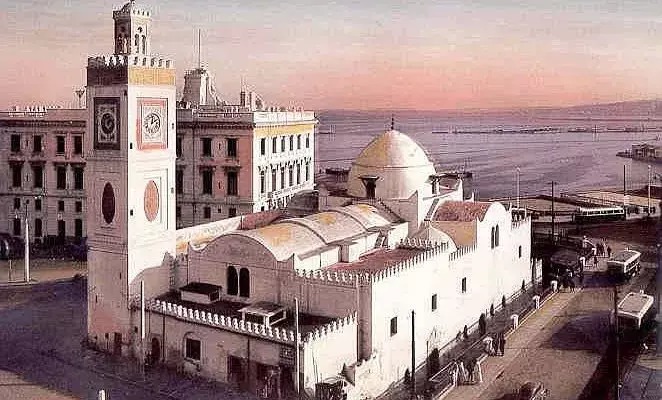
Great Mosque of Algiers (Djamaa el Kebi)
Overall Rating: ⭐⭐⭐⭐☆ (4/5)
Rating Breakdown:
✔ Historical Significance – ⭐⭐⭐⭐⭐ (5/5)
✔ Architectural Beauty – ⭐⭐⭐⭐☆ (4/5)
✔ Accessibility – ⭐⭐⭐☆☆ (3/5)
✔ Tourist-Friendly – ⭐⭐⭐☆☆ (3/5)
✔ Maintenance & Preservation – ⭐⭐⭐⭐☆ (4/5)
Weather
- Algiers experiences a Mediterranean climate characterized by hot, dry summers and mild, wet winters.
Tags
- Historic Mosque, Almoravid Architecture, Cultural HeritageWikipedia
Timings
- Visiting hours may vary; it's advisable to check locally or with tour operators for current schedules.
Time Required
- A visit typically requires 1 to 2 hours to explore the mosque thoroughly.alger.mta.gov.dz+4Wikipedia+4Log in or sign up to view+4
Entry Fee
- Entry fees, if applicable, should be confirmed on-site or through official channels.
Things to See & Do
- Architectural Exploration: Admire the Almoravid design featuring a rectangular floor plan, horseshoe arches, and a central aisle wider than the others, hinting at the T-plan layout characteristic of later mosque architecture in the Maghreb.
- Historical Significance: Learn about the mosque's establishment in 1097 and its role as one of the oldest mosques in Algiers, reflecting the city's rich Islamic heritage.
- Minaret: Observe the minaret added in 1322 by the Zayyanid Sultan Abu Tashfin I, featuring rectangular niches decorated with polylobed blind arches and ceramic tiles.
Best Time to Visit
- Spring (March to May) and autumn (September to November) offer pleasant weather, ideal for exploring the mosque and the surrounding Casbah.
Nearest Parking Spots
- Parking in the Casbah is limited; utilizing public transportation or taxis is recommended.
Overview
- The Great Mosque of Algiers stands as a testament to the city's rich history and architectural splendor. Constructed in 1097 during the Almoravid dynasty, it is one of the few remaining examples of Almoravid architecture and the oldest mosque in Algiers. Its strategic location in the Casbah, a UNESCO World Heritage site, adds to its cultural importance.
- Prayer Hall: Divided into eleven aisles running perpendicular to the qibla wall, featuring horseshoe arches supported by whitewashed masonry pillars.
- Minaret: Added in 1322, it showcases Zayyanid architectural elements with decorative niches and ceramic tiles.
- Courtyard: A rectangular courtyard measuring about 11 by 21 meters, surrounded by arcades, providing a serene space for visitors.
- Commissioned in 1097 during the reign of the Almoravid dynasty, the mosque has witnessed various historical events and undergone several modifications. The minaret was added in 1322 by the Zayyanid Sultan Abu Tashfin I. The mosque was damaged during French bombardments in the 17th century, leading to subsequent reconstructions, including the mihrab and qibla wall. In 1837, during French colonial rule, a portico with columns and polylobed arches was added to the façade.
- The mosque showcases Almoravid architecture with a rectangular floor plan measuring approximately 38 by 46 meters. The prayer hall is divided into eleven aisles by rows of horseshoe arches supported by masonry pillars, with the central aisle being wider, hinting at the T-plan layout. The minaret, added in 1322, features rectangular niches decorated with polylobed blind arches and ceramic tiles. The portico added in 1837 exhibits polylobed arches supported by columns, reflecting orientalizing styles introduced during the colonial period.
- Guided Tours: Engaging a local guide can enhance the experience by providing in-depth historical context.
- Dress Modestly: As a site of religious significance, it's respectful to wear modest attire.
- Photography: Check for any restrictions on photography within the mosque premises.
- Safety: Stay aware of your surroundings, especially when navigating the narrow streets of the Casbah.
- By Foot: Located in the Casbah near the harbor, it's accessible through the winding streets of the old city.